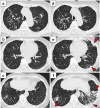Pneumonia Caused by Community-Acquired Methicillin-Resistant Staphylococcus aureus Positive for Exfoliative Toxin A and Secondary to Allergic Bronchopulmonary Aspergillosis
- PMID: 35774683
- PMCID: PMC9236638
- DOI: 10.7759/cureus.25334
Pneumonia Caused by Community-Acquired Methicillin-Resistant Staphylococcus aureus Positive for Exfoliative Toxin A and Secondary to Allergic Bronchopulmonary Aspergillosis
Abstract
Community-acquired methicillin-resistant Staphylococcus aureus (CA-MRSA) causes severe pneumonia. Previous reports found that CA-MRSA producing the Panton-Valentine leukocidin (PVL) or toxic shock syndrome toxin-1 (TSST-1) triggered severe necrotizing pneumonia. However, other toxins and genetic factors responsible for CA-MRSA pneumonia are rarely analyzed in Japan. In this study, we performed whole-genome sequencing (WGS) to analyze the clinical features of CA-MRSA genetically. As a result, we identified a strain with a rare sequence-type of MRSA. Herein, we present a case of CA-MRSA pneumonia in a 64-year-old woman. Her condition improved rapidly with vancomycin therapy. Draft WGS led to identifying the genotype and virulence factors and showed that the strain was a rare sequence-type of MRSA with the following characteristics: staphylococcal cassette chromosome mec (SCCmec) type IV, sequence type 121, exfoliative toxin A-positive, and specific staphylococcal protein A type t5110. To the best of our knowledge, a strain with this profile has not been previously reported. Our findings provide new insights into CA-MRSA pneumonia and its genetic and clinical features. Therefore, we recommend accumulating genetic profiles of CA-MRSA pneumonia to identify genetic features and the clinical characteristics of the patients.
Keywords: community-acquired methicillin-resistant staphylococcus aureus; community-acquired pneumonia; exfoliative toxin a; sequence type 121; whole-genome sequencing.
Copyright © 2022, Itano et al.
Conflict of interest statement
The authors have declared that no competing interests exist.
Figures



Similar articles
-
Two Cases of Intrafamilial Transmission of Community-Acquired Methicillin-Resistant Staphylococcus aureus Producing Both PVL and TSST-1 Causing Fatal Necrotizing Pneumonia and Sepsis.Infect Drug Resist. 2020 Aug 20;13:2921-2927. doi: 10.2147/IDR.S262123. eCollection 2020. Infect Drug Resist. 2020. PMID: 32903848 Free PMC article.
-
Molecular characteristics of community-acquired methicillin-resistant Staphylococcus aureus in Hokkaido, northern main island of Japan: identification of sequence types 6 and 59 Panton-Valentine leucocidin-positive community-acquired methicillin-resistant Staphylococcus aureus.Microb Drug Resist. 2011 Jun;17(2):241-50. doi: 10.1089/mdr.2010.0136. Epub 2011 Mar 13. Microb Drug Resist. 2011. PMID: 21395449
-
Community-acquired necrotizing pneumonia caused by methicillin-resistant Staphylococcus aureus producing Panton-Valentine leukocidin in a Chinese teenager: case report and literature review.Int J Infect Dis. 2014 Sep;26:17-21. doi: 10.1016/j.ijid.2014.02.025. Epub 2014 Jun 26. Int J Infect Dis. 2014. PMID: 24980464 Review.
-
Molecular Epidemiology of Community-Acquired Methicillin-Resistant Staphylococcus aureus and Clinical Characteristics of Different Sites of Infection.Infect Drug Resist. 2023 Mar 15;16:1485-1497. doi: 10.2147/IDR.S401998. eCollection 2023. Infect Drug Resist. 2023. PMID: 36945681 Free PMC article.
-
Acute haematogenous community-acquired methicillin-resistant Staphylococcus aureus osteomyelitis in an adult: case report and review of literature.BMC Infect Dis. 2012 Oct 25;12:270. doi: 10.1186/1471-2334-12-270. BMC Infect Dis. 2012. PMID: 23098162 Free PMC article. Review.
Cited by
-
Emergence of livestock-associated MRSA in the Egyptian Nile Delta that carry the exfoliative toxin gene etA: a case for enhanced surveillance.Eur J Clin Microbiol Infect Dis. 2025 Jul 5. doi: 10.1007/s10096-025-05163-z. Online ahead of print. Eur J Clin Microbiol Infect Dis. 2025. PMID: 40616708
References
-
- Methicillin-resistant Staphylococcus aureus. Lee AS, de Lencastre H, Garau J, Kluytmans J, Malhotra-Kumar S, Peschel A, Harbarth S. Nat Rev Dis Primers. 2018;4:18033. - PubMed
-
- Comparison of community- and health care-associated methicillin-resistant Staphylococcus aureus infection. Naimi TS, LeDell KH, Como-Sabetti K, et al. JAMA. 2003;290:2976–2984. - PubMed
-
- Molecular characteristics of methicillin-resistant Staphylococcus aureus (MRSA) strains isolated from patients with bacteremia based on MLST, SCCmec, spa, and agr locus types analysis. Goudarzi M, Seyedjavadi SS, Nasiri MJ, Goudarzi H, Sajadi Nia R, Dabiri H. Microb Pathog. 2017;104:328–335. - PubMed
Publication types
LinkOut - more resources
Full Text Sources
Research Materials
